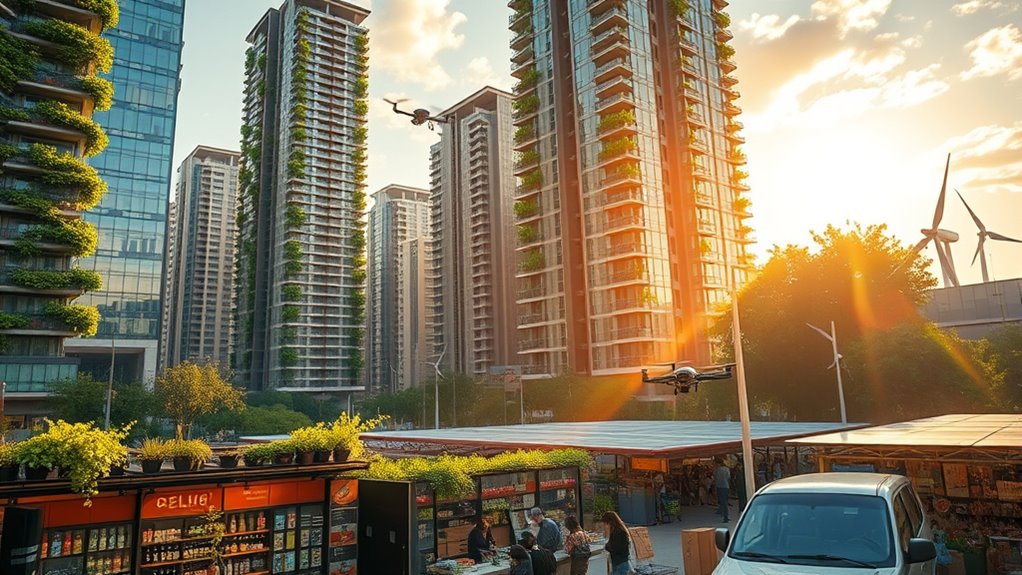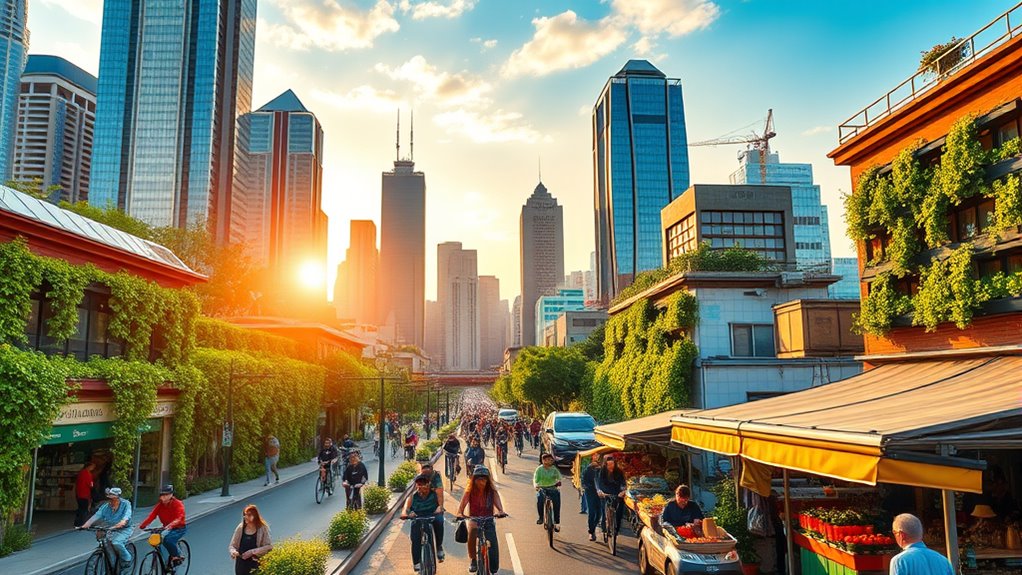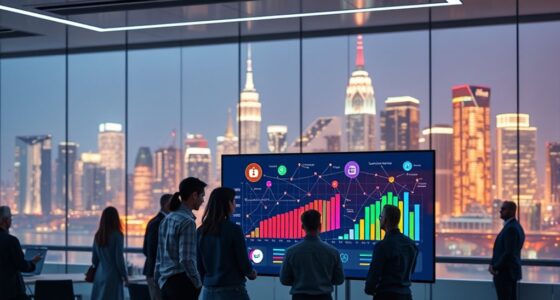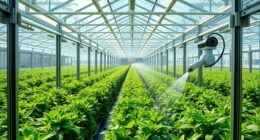By 2025, sustainability and the circular economy will be ingrained in your daily life and business practices. Expect eco-friendly packaging made from biodegradable or plant-based materials, designed for easy reuse or disposal. Companies will prioritize resource regeneration, balancing material extraction with natural replenishment. Products will be designed for disassembly and recycling, fostering waste reduction and resource efficiency. If you want to understand how these changes shape a resilient, eco-conscious future, there’s more to explore ahead.
Key Takeaways
- Circular economy practices are widespread, emphasizing product disassembly, reuse, and recycling to minimize waste.
- Eco-friendly packaging materials, such as biodegradable and plant-based plastics, are industry standards by 2025.
- Companies incorporate resource regeneration initiatives, balancing extraction with natural replenishment for sustainability.
- Take-back programs and transparent sustainability efforts strengthen consumer participation and accountability.
- Resource management focuses on long-term ecological health, fostering economic growth within a resilient, circular system.

Have you ever wondered what sustainability and the circular economy will look like in 2025? It’s likely that by then, eco-friendly packaging will be more than just a trend; it’ll be a standard practice across industries. Companies are increasingly adopting biodegradable materials, plant-based plastics, and innovative designs that minimize waste. Instead of lining shelves with single-use items, you’ll see products wrapped in packaging that breaks down naturally or can be easily reused. This shift isn’t just about reducing litter — it’s about fundamentally changing how products are designed from the outset. Eco-friendly packaging will be crafted with resource regeneration in mind, meaning that materials are sourced responsibly, and their lifecycle is extended through reuse and recycling. This approach guarantees that packaging doesn’t just end up in landfills but instead contributes to a continuous cycle of renewal.
By 2025, eco-friendly packaging will prioritize resource regeneration and circular design for sustainable consumption.
As resource regeneration becomes more integrated into business models, you’ll notice that companies actively work to replenish what they consume. For instance, manufacturers might invest in planting initiatives or support sustainable forestry to replace raw materials. This proactive attitude helps balance the extraction of resources with their natural replenishment, creating a more resilient supply chain. By 2025, resource regeneration will be embedded into the core of manufacturing practices, making it less about extraction and more about stewardship. Businesses will view resource management as a way to secure their long-term viability, not just meet immediate demands.
In this future landscape, you’ll see a shift toward circularity in every aspect of consumption. Products will be designed for easy disassembly, making it simpler to reclaim valuable materials for new products. Companies will develop take-back programs, encouraging consumers to return used items so they can be refurbished or recycled into new goods. This approach minimizes waste and maximizes resource efficiency, closing the loop and reducing the need for virgin raw materials. You’ll also notice increased transparency from brands about their sustainability efforts, giving you more confidence in your purchasing choices.
Ultimately, the transformation toward sustainable practices in 2025 will shape a world where waste is minimized, resources are valued, and economic growth aligns with ecological health. Eco-friendly packaging and resource regeneration won’t just be buzzwords—they’ll underpin a resilient, circular economy that benefits everyone. This future won’t happen by chance, but through deliberate actions by companies, consumers, and policymakers working together to create a more sustainable world.
Frequently Asked Questions
How Will Circular Economy Policies Differ Across Regions by 2025?
By 2025, you’ll notice regional policy variations shaped by cultural influences, which influence how circular economy practices are adopted. Some regions prioritize strict regulations and incentives, while others focus on community-led initiatives. Your approach should consider these differences, as policies may emphasize recycling, waste reduction, or resource sharing differently based on local values. Tailoring strategies to regional policy variations ensures more effective participation and sustainability efforts across diverse areas.
What New Technologies Will Drive Sustainability Efforts in 2025?
In 2025, AI integration will revolutionize your sustainability efforts by optimizing resource use and streamlining waste management. Material innovation will introduce new, eco-friendly materials that reduce your reliance on scarce resources and lower emissions. These technologies will help you implement circular economy principles more effectively, enabling smarter decisions and fostering more sustainable practices across industries. Embrace these advancements to stay ahead and make a significant impact on global sustainability goals.
How Will Consumer Behavior Shift Towards Circular Products by 2025?
By 2025, you’ll notice consumer awareness about sustainability considerably growing, prompting you to prefer circular products. You’ll develop stronger reuse habits, actively seeking items designed for longevity and easy recycling. Brands will emphasize transparency about their sustainability efforts, encouraging you to make eco-conscious choices. As a result, you’ll contribute to a circular economy by embracing products that can be reused, repurposed, or recycled, helping reduce waste and environmental impact.
What Are the Biggest Challenges in Implementing Circular Economy Models?
Implementing circular economy models is like steering through a maze, with resource scarcity and policy fragmentation as your biggest obstacles. You’ll struggle to align diverse regulations and secure enough raw materials, slowing progress. Overcoming these hurdles requires collaboration across sectors and governments. Without unified policies and sustainable resource management, the shift to circular practices remains an uphill climb, threatening to stall the momentum toward a more sustainable future.
How Will Circular Economy Principles Impact Global Supply Chains?
You’ll see circular economy principles transform global supply chains by emphasizing resource optimization and waste reduction. You’ll prioritize designing products for reuse and recycling, reducing dependency on virgin materials. This shift will streamline logistics, lower costs, and minimize environmental impact. As a result, supply chains become more resilient and sustainable, encouraging innovation and collaboration across industries to build a circular, efficient system that benefits businesses and the planet alike.
Conclusion
By 2025, embracing sustainability and the circular economy will be like planting seeds for a greener future—you’ll see the fruits of your efforts blossom in healthier communities and a healthier planet. Every small action you take becomes a essential thread in this vibrant tapestry of change. Together, you can turn the tide, making sustainability not just a goal, but a way of life that sustains us all. The future’s green horizon is within your reach—step into it.









